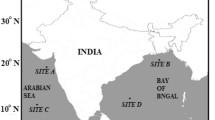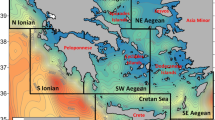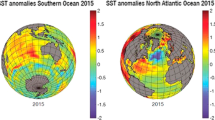Abstract
High temporal resolution remote sensing images provide continuous data about the marine environment, which is critical for gaining extensive knowledge about the aquatic environment and marine species. Sea surface temperature (SST) is one of the basic parameters that can be obtained with the help of remote sensing. Long-term alterations in the SST can affect the aquatic environment and marine species, such as the life expectancy of anchovies in the Black Sea. Forecasting the dynamics of SSTs is crucial for detecting and eliminating the SST-oriented impacts. The goal of the current study is to construct a predictive model to estimate the daily SST value for the mid-Black Sea using a machine learning approach by employing time-series satellite data from 2008 to 2021. Turkey’s mid-Black Sea coastal line, comprising Ordu, Samsun, and Sinop stations, was chosen as the study area. The SST predictive model was represented by applying the recurrent neural network (RNN) long- and short-term memory (LSTM). Adam stochastic optimization was used for validation, and the mean square error (MSE) for each location was found to be 0.914, 0.815, and 0.802, respectively. The findings indicate that our model is significantly promising for accurate and effective short- and midterm daily SST prediction.









Similar content being viewed by others
Data availability
The data of the study will be provided upon request.
Code availability
The data of the study will be provided upon request.
References
Aparna S, D’souza S, Arjun N (2018) Prediction of daily sea surface temperature using artificial neural networks. Int J Remote Sens 39(12):4214–4231
Bouali M, Sato OT, Polito PS (2017) Temporal trends in sea surface temperature gradients in the South Atlantic Ocean. Remote Sens Environ 194:100–114
Cane MA, Clement AC, Kaplan A, Kushnir Y, Pozdnyakov D, Seager R, Zebiak SE, Murtugudde R (1997) Twentieth-Century Sea Surface Temp Trends Sci 275(5302):957–960
Castro SL, Wick GA, Steele M (2016) Validation of satellite sea surface temperature analyses in the Beaufort Sea using UpTempO buoys. Remote Sens Environ 187:458–475
Chaidez V, Dreano D, Agusti S, Duarte CM, Hoteit I (2017) Decadal trends in Red Sea maximum surface temperature. Sci Rep 7(1):1–8
Dabanli I, Şişman E, Güçlü YS, Birpınar ME, Şen Z (2021) Climate change impacts on sea surface temperature (SST) trend around Turkey seashores. Acta Geophys 69(1):295–305
Dong B, Dai A, Vuille M, Timm OE (2018) Asymmetric modulation of ENSO teleconnections by the interdecadal Pacific oscillation. J Clim 31(18):7337–7361
Emery W, Castro S, Wick G, Schluessel P, Donlon C (2001) Estimating sea surface temperature from infrared satellite and in situ temperature data. Bull Am Meteorol Soc 82(12):2773–2786
Friedel MJ (2012) Data-driven modeling of surface temperature anomaly and solar activity trends. Environ Model Softw 37:217–232
Feng Y, Sun T, Li C (2021) Study on long term sea surface temperature (SST) prediction based on temporal convolutional network (TCN) Method. Paper presented at the ACM Turing Award Celebration Conference-China (ACM TURC 2021).
Ghalenoei E, Hasanlou M, Sharifi MA, Vignudelli S, Foroughi I (2017) Spatiotemporal monitoring of upwelled water motions using optical flow method in the Eastern Coasts of Caspian Sea. J Appl Remote Sens 11(3):036016
Güçlü Y (2013) Sea surface temperature anomalies along the Black Sea Region coast of Turkey (1971–2010 period) Türkiye’nin Karadeniz Bölgesi kıyısı boyunca deniz suyu yüzey sıcaklığı anomalileri (1971–2010 dönemi). J Hum Sci 10(1):863–896
Güraslan C (2010) The impact of climate variability on the production of black sea anchovy: a modelling study. (Master Thesis), Middle East University, Ankara.
Herbert TD, Peterson LC, Lawrence KT, Liu Z (2010) Tropical ocean temperatures over the past 3.5 million years. Sci. 328(5985):1530–1534
Hochreiter S, Schmidhuber J (1997) Long short-term memory. Neural Comput 9(8):1735–1780
Jha B, Hu Z-Z, Kumar A (2014) SST and ENSO variability and change simulated in historical experiments of CMIP5 models. Clim Dyn 42(7):2113–2124
Kayhan FE, Kaymak G, Tartar Ş, Akbulut C, Esmer HE, Ertuğ NDY (2015) Küresel ısınmanın balıklar ve deniz ekosistemleri üzerine etkileri. Erzincan Üniv Fen Bilim Enst Derg 31(3):128–134
Kazmin AS, Zatsepin AG (2007) Long-term variability of surface temperature in the Black Sea, and its connection with the large-scale atmospheric forcing. J Mar Syst 68(1–2):293–301
Kilpatrick KA, Podestá G, Walsh S, Williams E, Halliwell V, Szczodrak M, Brown O, Minnett P, Evans R (2015) A decade of sea surface temperature from MODIS. Remote Sens Environ 165:27–41
Krishnamurti T, Chakraborty A, Krishnamurti R, Dewar WK, Clayson CA (2006) Seasonal prediction of sea surface temperature anomalies using a suite of 13 coupled atmosphere–ocean models. J Clim 19(23):6069–6088
Ketkar N (2017) Introduction to keras. In: Deep learning with Python (pp. 97–111): Springer.
Lins ID, Araujo M, das Chagas Moura M, Silva MA, Droguett EL (2013) Prediction of sea surface temperature in the tropical Atlantic by support vector machines. Comput. Stat. Data Anal. 61:187–198
Liu G, Strong AE, Skirving W (2003) Remote sensing of sea surface temperatures during 2002 Barrier Reef coral bleaching. EOS Trans Am Geophys Union 84(15):137–141
Laepple T, Jewson S (2007) Five year ahead prediction of sea surface temperature in the Tropical Atlantic: a comparison between IPCC climate models and simple statistical methods. arXiv preprint physics/0701165.
Mol S, Doğruyol H (2012) The effect of climate change on seafood and their consumption. J Fishscicom 6(4):341–356
Nardelli BB, Tronconi C, Pisano A, Santoleri R (2013) High and Ultra-High resolution processing of satellite Sea Surface Temperature data over Southern European Seas in the framework of MyOcean project. Remote Sens Environ 129:1–16
Nurdin S, Mustapha MA, Lihan T, Abd Ghaffar M (2015) Determination of potential fishing grounds of Rastrelliger kanagurta using satellite remote sensing and GIS technique. Sains Malaysiana 44(2):225–232
Patil K, Deo MC (2017) Prediction of daily sea surface temperature using efficient neural networks. Ocean Dyn 67(3):357–368
Rauscher SA, Jiang X, Steiner A, Williams AP, Cai DM, McDowell NG (2015) Sea surface temperature warming patterns and future vegetation change. J Clim 28(20):7943–7961
Senatore A, Mendicino G, Knoche HR, Kunstmann H (2014) Sensitivity of modeled precipitation to sea surface temperature in regions with complex topography and coastlines: a case study for the Mediterranean. J Hydrometeorol 15(6):2370–2396
Shehata N, Meehan K, Leber DE (2012) Oceanography of Skeletonema costatum harmful algal blooms in the East China Sea using MODIS and QuickSCAT satellite data. J Appl Remote Sens 6(1):063529
Shrestha A, Serra E, Spezzano F (2020) Multi-modal social and psycho-linguistic embedding via recurrent neural networks to identify depressed users in online forums. Netw Model Anal Health Inform Bioinform 9(1):1–11
Stockdale TN, Balmaseda MA, Vidard A (2006) Tropical Atlantic SST prediction with coupled ocean–atmosphere GCMs. J Clim 19(23):6047–6061
Sumner MD, Michael KJ, Bradshaw CJ, Hindell MA (2003) Remote sensing of Southern Ocean sea surface temperature: implications for marine biophysical models. Remote Sens Environ 84(2):161–173
Shapiro G (2009) Black Sea circulation. Ocean Currents 2(8).
Tangang FT, Hsieh WW, Tang B (1998) Forecasting regional sea surface temperatures in the tropical Pacific by neural network models, with wind stress and sea level pressure as predictors. J Geophys Res Oceans 103(C4):7511–7522
Thomas A, Byrne D, Weatherbee R (2002) Coastal sea surface temperature variability from Landsat infrared data. Remote Sens Environ 81(2–3):262–272
Wang X, Gong C, Hu Y, Wang X, Li L, He Z (2021) Retrieval of sea surface temperature and thermal discharge monitoring in nuclear power plant using Gaofen-5 satellite remote sensing imagery. J Appl Remote Sens 16(1):012013
Wentz FJ, Gentemann C, Smith D, Chelton D (2000) Satellite measurements of sea surface temperature through clouds. Sci 288(5467):847–850
Wolff S, O’Donncha F, Chen B (2020) Statistical and machine learning ensemble modelling to forecast sea surface temperature. J Mar Syst 208:103347
Wu A, Hsieh WW, Tang B (2006) Neural network forecasts of the tropical Pacific sea surface temperatures. Neural Netw 19(2):145–154
Xiao C, Chen N, Hu C, Wang K, Xu Z, Cai Y, Xu L, Chen Z, Gong J (2019) A spatiotemporal deep learning model for sea surface temperature field prediction using time-series satellite data. Environ Model Softw 120:104502
Xue Y, Leetmaa A (2000) Forecasts of tropical Pacific SST and sea level using a Markov model. Geophys Res Lett 27(17):2701–2704
Yang Y, Dong J, Sun X, Lima E, Mu Q, Wang X (2017) A CFCC-LSTM model for sea surface temperature prediction. IEEE Geosci Remote Sens 15(2):207–211
Yao S-L, Luo J-J, Huang G, Wang P (2017) Distinct global warming rates tied to multiple ocean surface temperature changes. Nat Clim Change 7(7):486–491
Zang L, Mao F, Guo J, Gong W, Wang W, Pan Z (2018) Estimating hourly PM1 concentrations from Himawari-8 aerosol optical depth in China. Environ Pollut 241:654–663
Zhang Q, Wang H, Dong J, Zhong G, Sun X (2017) Prediction of sea surface temperature using long short-term memory. IEEE Geosci Remote Sens 14(10):1745–1749
Acknowledgements
This research was conducted as a part Studio IIA lecture by Remote Sensing and Geographical Information System Department in Eskisehir Technical University. The authors would like to express their sincere gratitude to Prof. Dr. Saye Nihan Çabuk for the continuous support during the study. The data and code used in this research will be provided to interested researchers upon request.
Author information
Authors and Affiliations
Contributions
Conceptualization and design: Hakan Oktay Aydınlı. Data collection: Mervegül Aykanat Atay, Berkan Sarıtaş. Analysis of data and interpretation of results: Ali Ekincek, Hakan Oktay Aydınlı. Writing the first draft of the manuscript: Hakan Oktay Aydınlı. Review and editing: Hakan Oktay Aydınlı, Mehtap Özenen-Kavlak.
Corresponding author
Ethics declarations
Competing interests
The authors declare no competing interests.
Rights and permissions
Springer Nature or its licensor holds exclusive rights to this article under a publishing agreement with the author(s) or other rightsholder(s); author self-archiving of the accepted manuscript version of this article is solely governed by the terms of such publishing agreement and applicable law.
About this article
Cite this article
Aydınlı, H.O., Ekincek, A., Aykanat-Atay, M. et al. Sea surface temperature prediction model for the Black Sea by employing time-series satellite data: a machine learning approach. Appl Geomat 14, 669–678 (2022). https://doi.org/10.1007/s12518-022-00462-y
Received:
Accepted:
Published:
Issue Date:
DOI: https://doi.org/10.1007/s12518-022-00462-y




